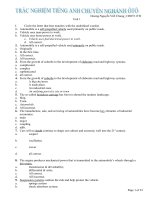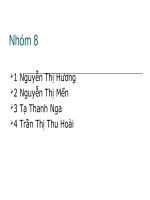Slide tiếng anh ngành marketing neu
Bạn đang xem bản rút gọn của tài liệu. Xem và tải ngay bản đầy đủ của tài liệu tại đây (5.3 MB, 164 trang )
NATIONAL ECONOMICS UNIVERSITY
MARKETING FACULTY
Marketing Department
ENGLISH FOR MARKETING
COURSE NUMBER: MKMA1112
CREDIT: 03
CuuDuongThanCong.com
/>
Faculty and Department Information
• Faculty: Marketing
• Department: Marketing
• Office Address: R1305 – A1 building – NEU
• Website: />• Lecturer:
• Email:
CuuDuongThanCong.com
/>
COURSE STRUCTURE
Unit 1
Unit 2
Unit 3
Unit 4
Unit 5
Unit 6
Unit 7
Unit 8
Unit 9
Unit 10
CuuDuongThanCong.com
• Marketing Introduction
• Marketing Environment
• Marketing Information and Research
• Consumer Behaviour
• Segmentation - Targeting - Positioning
• Company and Marketing Strategy
• Product
• Price
• Places
• Promotion
/>
Books and references
Course Book:
• Phillip Kotler, Gary Amstrong “Principles of Marketing”, Pearson Education Limited, 2014.
Reference Books:
• Cate Farrall (2008). Professional English in use - Marketing. Cambridge University Press
• Simon Sweeney (2002). Test your Professional English – Marketing. Pearson Education
Limited.
• Sylee Gore (2007). English for Marketing and Advertising. Oxford Business English.
CuuDuongThanCong.com
/>
Assessments
• Participation: 10%: attendance and participation in class
• Mid term: 20% - in class test, closed book (expected in week 5)
• Group assignment and presentation: 20% (expected in week
10)
• Final exam: 50% - closed book (expected in week 15)
CuuDuongThanCong.com
/>
Group Assignment
• Topic: Choose a product/ service (in Vietnam or foreign country) and develop a
marketing plan for it in Vietnamese market.
• Presentation: maximum 15 minutes – no extension (grade will be deducted if
overtime)
• Group report (in word, printed):
• Submit before the presentation date (exact date will be informed by lecturer)
• Length: 20-30 pages.
• Logic, straight and simple presentation
CuuDuongThanCong.com
/>
Group Assignment
•
Turnitin report: below 20%
•
Team evaluation: submit individually.
•
Grade structure:
• 50% word report
• 50% presentation: each member should make appearance in the
presentation, either presenter or ask questions for other groups, or answer
questions from other groups
•
Grades will be evaluated individually
CuuDuongThanCong.com
/>
Class regulations
#1
On time (if you are late than teachers, pls. wait until the break)
#2
No voice in class (pls. show the respect for lecturer and others)
#3
No sleep (if you feel sleepy, feel free to go out, no need to ask for lecturer’s
permission)
#4
No food (but drinks are permitted)
#5
No cellphone (switch off your phone ring before class starting)
#6
No laptop, ipad, ipod and others…
CuuDuongThanCong.com
/>
UNIT 1
MARKETING INTRODUCTION
CuuDuongThanCong.com
/>
Objectives
• Understand and being able to use marketing basic terms correctly
• Understand the marketing process extended model
• Understand the marketing management orientation
• Being aware of the modern marketing landscape
CuuDuongThanCong.com
/>
Marketing Introduction
Core concepts:
• What is marketing?
• Market basic definitions
• Marketing strategy and the marketing plan
• The marketing mix
• The Changing Marketing Landscape
CuuDuongThanCong.com
/>
Marketing is:
Managing profitable customer relationship
The process by which companies:
create value for customers &
build strong customer relationship
in order to
capture value from customers in return
- Philips Kotler-
CuuDuongThanCong.com
/>
Marketing basic definitions
• Customer needs, wants, and demands
• Market offerings
• Customer Value, Costs and Satisfaction
• Exchanges and Relationships
• Markets
• Marketing process
• Marketing management
• Marketing management orientations
CuuDuongThanCong.com
/>
Needs
Sates of felt deprivation
• Physical needs: food, clothing, warmth
and safety
• Social needs: belonging and affection
• Individual needs: knowledge and self
expression
Marketers did not create these needs, they
are basic part of the human.
Help the company:
Identify the industry, the type of products that they
want to market
Answer the question: what customer’s need our
product will satisfy
CuuDuongThanCong.com
/>
Wants:
• Is human needs
• but are shaped by personal preferences/ culture/
religion …
• People have unlimited wants but limited resources
• Help the company:
– Decide the features, characteristics of the products/ services
– Competitive on the market
CuuDuongThanCong.com
/>
Demands:
• Human wants that are backed by
buying power
• Willing to buy
• Ability to pay
CuuDuongThanCong.com
/>
Some combination of products,
services, information, or
experiences offered to a market
to satisfy
a need or want
Products
Places
Services
Experience
Market offerings
Ideas
CuuDuongThanCong.com
People
/>
Exchange
The act of obtaining a
desired object from someone
by offering something in
return
CuuDuongThanCong.com
/>
The set of all actual and potential buyers of a product or
service
CuuDuongThanCong.com
/>
Understand the
marketplace and
customer needs
and wants
Research
customers and
the marketplace
Manage
marketing
information and
customer data
Design a
customerdriven
marketing
strategy
Select
customers to
serve: market
segmentation
and targeting
Decide on a
value
proposition:
differentiation
and positioning
Construct an
integrated
marketing program
that delivers
superior value
Product decisions
Pricing decisions
Building
profitable
relationships and
create customer
delight
Customer
relationship
management:
build strong
relationships
with chosen
customers
Distribution:
manage demand
and supply chains
Promotion:
communicate the
value proposition
Capture value
from customers to
create profits and
customer equity
Create satisfied,
loyal customers
Capture customer
lifetime value
Partner
relationship
management:
build strong
relationships
with marketing
partners
Increase share of
market and share
of customer
An expanded model of the marketing process
CuuDuongThanCong.com
/>
Marketing management
Marketing management is the art and
science of choosing target markets and
building profitable relationships with
them
– What customers will we serve?
– How can we best serve these customers?
CuuDuongThanCong.com
/>
MARKETING MANAGEMENT ORIENTATIONS
Production concept
The idea that consumers will favor
products that are available and highly
affordable and that the organization
should therefore focus on improving
production and distribution efficiency
Product concept
Consumers will favor products that offer
the most quality, performance and
features and that the organization
should therefore devote its energy to
making continuous product
improvements
Selling concept
The idea that consumers will not buy
enough of the firm’s products unless it
undertakes a large-scale selling and
promotion effort
Marketing concept
A philosophy that holds that achieving
organizational goals depends on
knowing the needs and wants of
target markets and delivering the
desired satisfactions better than
competitors do
Societal marketing concept
The idea that a company’s marketing decisions should consider consumer’s wants,
the company’s requirements, consumers’ long-run interests, and society’s longrun interests
CuuDuongThanCong.com
/>
Designing a Customer-Driven
Marketing Strategy
CuuDuongThanCong.com
/>
Designing a Customer-Driven Marketing
Strategy
Selecting Customers to Serve
• Market segmentation refers to dividing the markets into
segments of customers
• Target marketing refers to which segments to go after
CuuDuongThanCong.com
/>
The marketing mix is the set of
tools (four Ps) the firm uses to
implement its marketing strategy.
It includes product, price,
promotion, and place.
Marketing Mix –
4Ps
CuuDuongThanCong.com
/>









